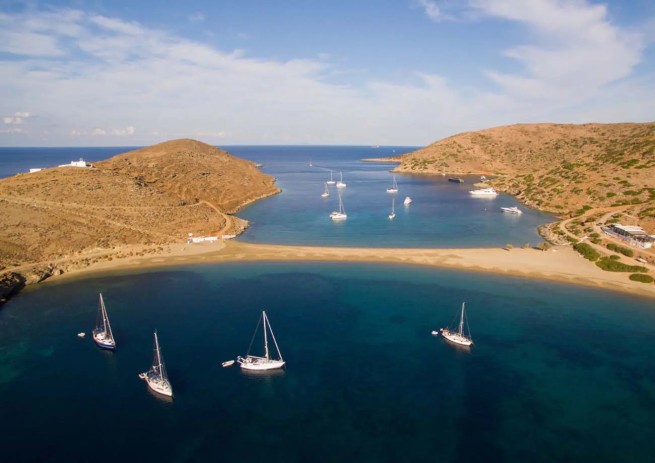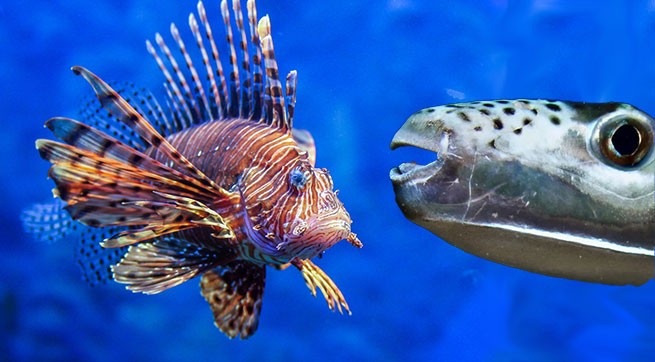The silver pufferfish and the rabbitfish are two “killer fish” of the Greek seas that migrated from the Indian Ocean through the Suez Canal to the Mediterranean Sea.
Both fish are active predators that threaten the marine ecosystem and are also dangerous to humans.
Silver pufferfish or lionfish (λεοντόψαρο)
The silver pufferfish is a striking fish armed with long, sharp spines, edible, but armed with needles that secrete a poison that can cause allergic shock in humanswhile The rabbit fish is dangerous because of its teeth, and it is also toxic, and its consumption can even lead to death.
“I had caught a rabbitfish before, but this was the first time I had seen a silver pufferfish, but I knew what it was. How As soon as I saw her, I recognized her and told my father not to touch her,” says Mr. Murikis.
The silver pufferfish (scientific name Pterois miles), found in the Indian Ocean, is a popular tropical aquarium exhibit due to its striking red, yellow and black colours and its 'armour' of poison-producing spines. These serve as both a defensive and offensive mechanism, scaring off potential predators and capturing prey. Human contact with the spines can be painful or even fatal, as there is a risk of allergic shock.
The lionfish lives in warm waters and has penetrated into the Mediterranean in recent years. It was first confirmed in Israel and then in Cyprus, where its presence is now considered permanent. At the same time, lionfish have been caught on the southern coast of Turkey and in Greek waters, in Kastellorizo, Rhodes and elsewhere, and are increasingly penetrating northwards. Karlovasi on Samos is one of the northernmost areas where it has been spotted.
Rabbit fish (λαγοκέφαλος)
This species has been a major concern to the scientific community since 2003, when it was first discovered in the waters of the Eastern Mediterranean. This fish is considered the second most toxic animal on the planet due to the tetrodotoxin it contains (its close relative is the famous fugu).
Tetrodotoxin in fish of this family is concentrated mainly in the liver, genitals and muscle tissue, and affects humans only when they eat it, and not when a rabbit injures them with its teeth.
Tetrodotoxin causes muscle paralysis, blocks the nervous system and can lead to death. It is considered to be 1,250 times more potent than cyanide and has no known antidote.
Fatalities recorded in Lebanon and Israeland in April 2016, a 65-year-old Cypriot woman and her son ate the fish and ended up in the intensive care unit of a Nicosia hospital fighting for their lives. Cases of poisoning in other parts of the Mediterranean, including Crete, have been attributed to the consumption of the fish, but have not been officially confirmed. The spread of rabbitfish in the Mediterranean has been rapid in recent years, and the scientific community is looking for a way to dramatically reduce its population.
Recently, information provided by the relevant authorities has paid off and professional fishermen are well aware of this fish and how dangerous it is, but this is not the case for amateur fishermen. In fact, it is easy to identify: the back is silvery-blue with many black spots, and the head is similar to a hare's, from which it gets its name. The harehead tends to become the dominant species in the Dodecanese region and in the eastern Cretan Sea. This is especially troublesome for professional fishermen in the area.
In addition to being an excellent predator, this species poses a serious threat to the ecosystem and causes enormous damage to nets, as the fish easily nibble on them, as well as to other equipment of fishermen. In the Gulf of Merabello, in the prefecture of Lasithi, signs of ecological destruction are already clearly visible.
In November 2016, a half-meter rabbitfish was caught in the port of Heraklion. The poison of one specimen can easily kill 30 people…







More Stories
Symptoms of overheating and heatstroke
Detailed instructions from the fire service in case of a possible fire (video)
The most dangerous areas of Athens